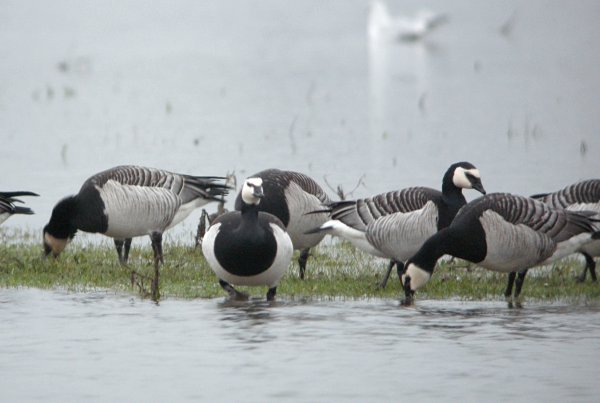We've finished the year as we started with extensive flooding heading all the way up to Wolvercote. By many measures it's been a rather strange year on the Patch. We had a fantastic start to the year and managed to pick up almost all the species that we might expect in the first five months of the year. In fact by the end of May we'd managed a year list total of 133 with which one would be reasonably happy for the whole year. After that it all went a bit pear-shaped!
Of particular note in January this year was the large flock of Barnacle Geese which made the floods their home for a few days. Usually Barnacle Geese appear in small numbers in the county as escapee's etc and aren't "tickable" at all but these birds were part of the large feral flocks that live in the home counties and which are classified as official Category C birds and therefore officially tickable. They're at least as tickable as the Greylags that everyone has no problem counting in their county year list so I was rather surprised that more county listers didn't come to see them.
Tickable Barnacle Geese
Last winter was of course a great one for Waxwings and we had quite a few sightings of these lovely birds to start off the year.
A Firecrest that was found by Tom Evans in the Trap Grounds was a great record for the Patch (the first and only one on the Meadow to my knowledge).
Gary the Adult Glauc
In particular the gulling was superb at the start of the year with Caspian Gulls, Iceland Gulls
and Glaucous Gulls including a splendid adult bird (a very rare age for this species in
the county) which spent several weeks visiting the floods on and off.
By many counts spring was rather disappointing from a wader point of view. Sure we managed to see all the common species that we would normally expect but the floods started fading just at the critical time and there were no Wood Sandpipers this year - normally we might expect several of these rarer waders in the spring on the Meadow. We were blessed with several Avocet in March though which were nice to see.
Avocets (c) Roger Wyatt
We did have a good spring for passage passerines with several Redstarts in Burgess Field (normally a very rare bird on the Patch), plus some Whinchat and even a confiding Tree Pipit.
Burgess Field Tree Pipit
A summer plumaged adult Little Stint at the end of April was a nice bird - this age and plumage is rare in the county.
Adult Spring Little Stint
By the time we were getting to May, the floods were starting to look rather stale and in severe need of a top-up and during this month they basically more or less dried up completely. Still we managed to attract several Garganey; some Whimbrel also popped in albeit briefly.
Garganey are always lovely to see
June was basically flood-free though a couple of probable Spoonbills in the last puddle in early June added some excitement. Steve Goddard managed to turn up an Upper Thames area moth first in the form of the micro
Telechrysis tripuncta.
Telechrysis tripuncta
After that it got very quiet for a while with just butterflies and moths to break the tedium of what was largely a birdless desert. I managed to find a rare micro as well with this Metalampa Italica, only the third ever record for the area. July, August and September seemed to drag on for ever with no flood water and no birds.
Metalampa Italica
Finally, in the start of October a birding miracle happened. I was just trudging back from another fruitless search of the still bone dry Meadow when I heard the unmistakable call of a Yellow-browed Warbler. It was a good autumn for this Siberian vagrant nationally and fortunately one chose to linger for a few days at the bottom of Walton Well Road by the car park.
The Yellow-browed Warbler (c) Roger Wyatt
After that it was back to birdlessness until the second half of the month when, thanks to some decent rainfall, the flood waters finally returned. These remained until the end of the year and with the water came the returning gulls which kept me happily occupied for the rest of the year. The highlights of the last two months were three Caspian Gulls (two adults and a 1st winter) and a juvenile Iceland Gull.
Caspian Gull
Iceland Gull
So that was the year on the Meadow. The final year list total was 134 with the Yellow-browed Warbler being the only addition in the second half of the year. There's no doubt that this warbler should get the title of "Bird of the Year" on the Meadow - it was a real gem. I feel really privileged to have such a wonderful patch so close to home which I can visit - it really is a joy to bird. Let's hope for an even better 2014.















